Honor Award
Asylum Air Pupa in the Landscape
Zhinian Dong, Student Affiliate ASLA; Changlin Fan, Student Affiliate ASLA; Hongxia Wang, Student Affiliate ASLA; Yiding Wang, Student Affiliate ASLA; and Chao Zhou, Student Affiliate ASLA, Undergraduate, Beijing Institute of Fashion Technology and Tsinghua University
Faculty Advisor: Liuting Chen
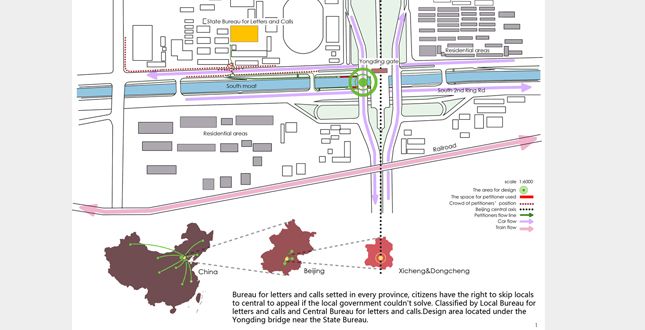 Close Me!
Close Me!Site Plan. Bureau for letters and calls setted in every province, citizens have the right to skip locals to central to appeal if the local government couldn't solve. Classified by Local Bureau for letters and calls and Central Bureau for letters and calls.Design area located under the Yongding bridge near the State Bureau.
Download Hi-Res ImageImage: Zhinian Dong, Changlin Fan, Hongxia Wang, Yiding Wang, and Chao Zhou
Image 1 of 15
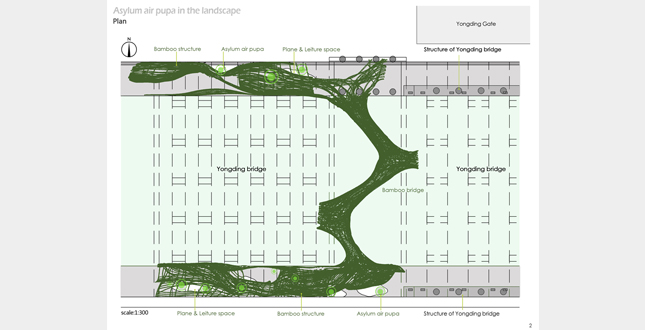 Close Me!
Close Me!Design Plan.
Download Hi-Res ImageImage: Zhinian Dong, Changlin Fan, Hongxia Wang, Yiding Wang, and Chao Zhou
Image 2 of 15
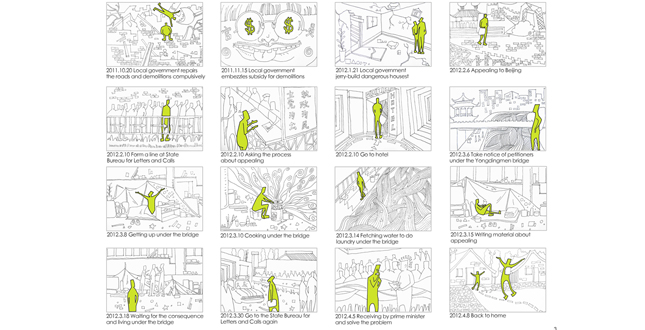 Close Me!
Close Me!Petition and Petitioner. Ms. Wang`s petitioning process.
Download Hi-Res ImageImage: Zhinian Dong, Changlin Fan, Hongxia Wang, Yiding Wang, and Chao Zhou
Image 3 of 15
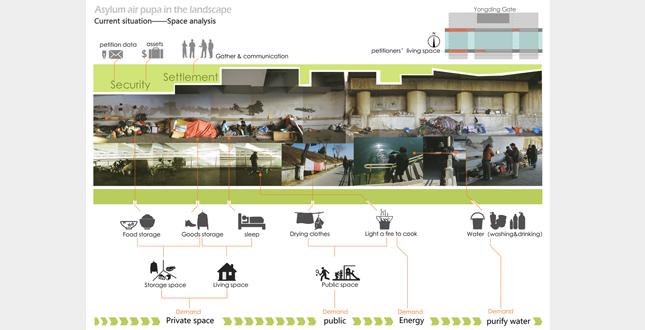 Close Me!
Close Me!Status Quo. Analyze the petitioners’ living space under the bridge of Yongding Gate.
Download Hi-Res ImageImage: Zhinian Dong, Changlin Fan, Hongxia Wang, Yiding Wang, and Chao Zhou
Image 4 of 15
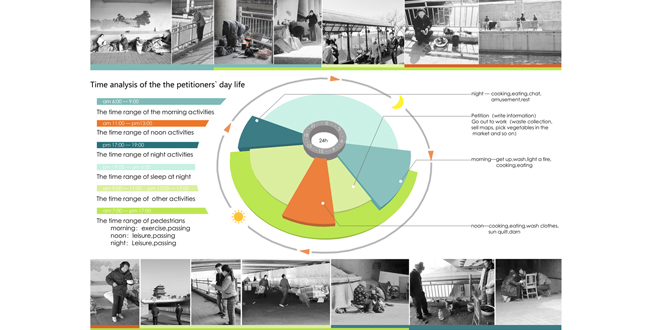 Close Me!
Close Me!Status Quo. Analyze the petitioners' timetable in their daily lives.
Download Hi-Res ImageImage: Zhinian Dong, Changlin Fan, Hongxia Wang, Yiding Wang, and Chao Zhou
Image 5 of 15
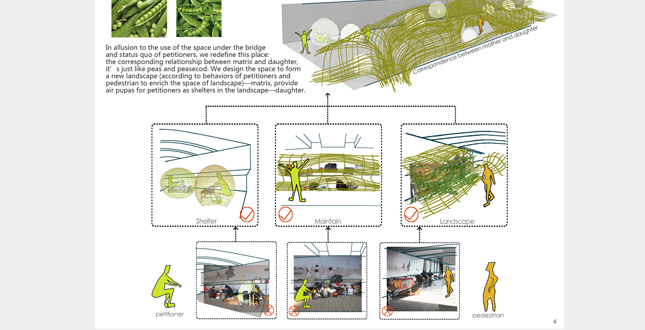 Close Me!
Close Me!The Concept. We redefine the petitioners' living space under the bridge based on the status Que: the corresponding relationship between matrix and draughts, which is just like peas and peasecod. We design the space to become a new landscape (according to behaviors of petitioners to enrich the space of landscape) — matrix, there are air pupa for petitioners as shelters in the landscape — daughter.
Download Hi-Res ImageImage: Zhinian Dong, Changlin Fan, Hongxia Wang, Yiding Wang, and Chao Zhou
Image 6 of 15
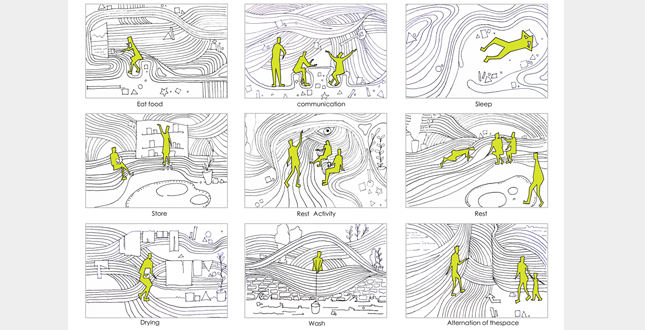 Close Me!
Close Me!People`s Behaviors in the Bamboo Ppace. The scale of the bamboo structure derives from the figures' actions.
Download Hi-Res ImageImage: Zhinian Dong, Changlin Fan, Hongxia Wang, Yiding Wang, and Chao Zhou
Image 7 of 15
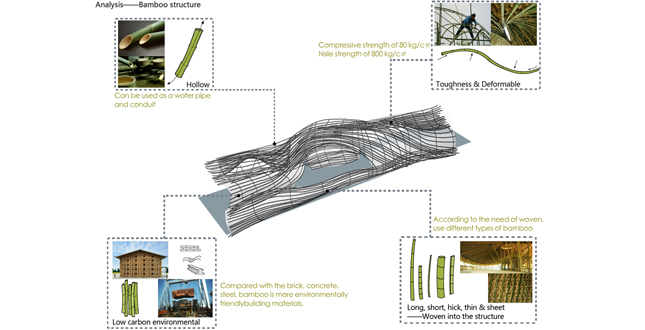 Close Me!
Close Me!Features of Bamboo. Bamboo is easy to get in China. Compared with rebar, brick, concrete and other building materials, bamboo features low-carbon green, low cost, and it has high toughness, high deformability, high axial rigidity and light weight.
Download Hi-Res ImageImage: Zhinian Dong, Changlin Fan, Hongxia Wang, Yiding Wang, and Chao Zhou
Image 8 of 15
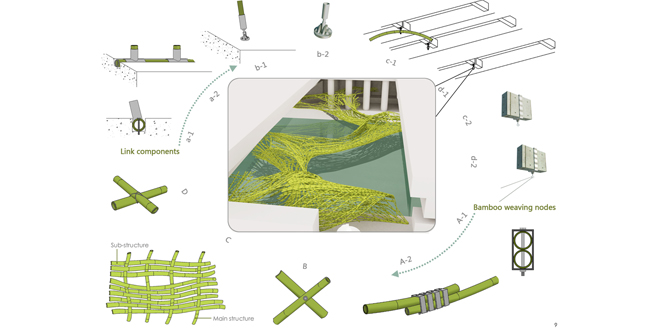 Close Me!
Close Me!Join Node of Bamboo Weaving Structure. Join node between the structure and the bridge, join nodes in the structure itself.
Download Hi-Res ImageImage: Zhinian Dong, Changlin Fan, Hongxia Wang, Yiding Wang, and Chao Zhou
Image 9 of 15
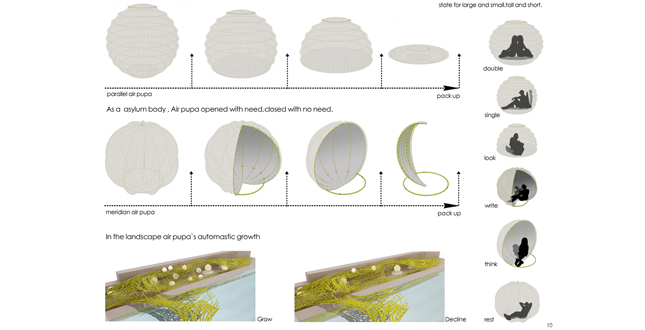 Close Me!
Close Me!Air Pupa. As a shelter, air pupa can open when using and fold in at other time to make the space free. meanwhile, air pupa could become privacy or half-privacy space according to the requirements of petitioners.
Download Hi-Res ImageImage: Zhinian Dong, Changlin Fan, Hongxia Wang, Yiding Wang, and Chao Zhou
Image 10 of 15
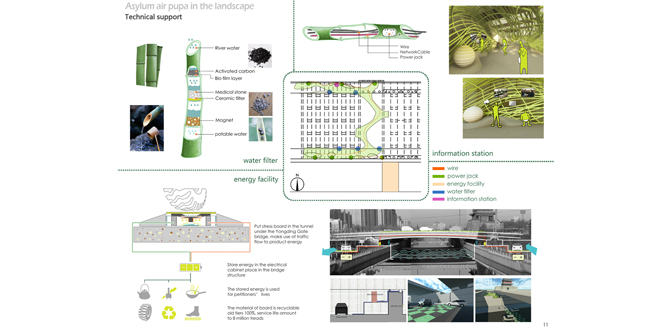 Close Me!
Close Me!Technical Support. Bamboo weaving structure in the landscape could provide energy facility, water filters system and information station needed by petitioners.
Download Hi-Res ImageImage: Zhinian Dong, Changlin Fan, Hongxia Wang, Yiding Wang, and Chao Zhou
Image 11 of 15
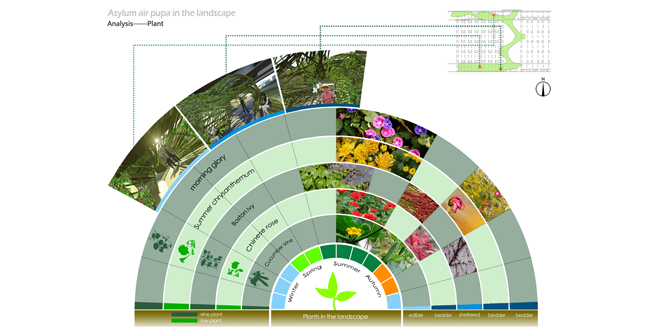 Close Me!
Close Me!Plant Grows in the Landscape. Plant seasonal vine plants and low plants, flourishing at summer, fading at winter.Constitute plants for view, shelter and product.
Download Hi-Res ImageImage: Zhinian Dong, Changlin Fan, Hongxia Wang, Yiding Wang, and Chao Zhou
Image 12 of 15
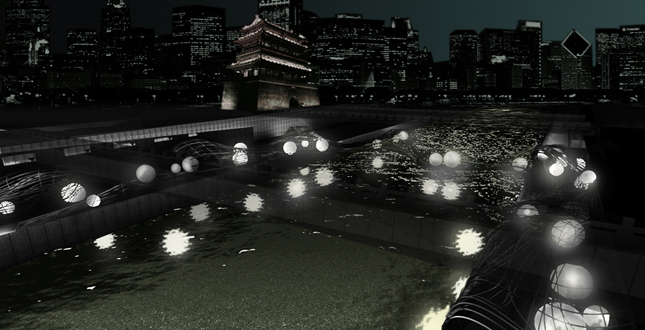 Close Me!
Close Me!Night Scene. Petitioners stay in the asylum air pupa at night, have their own shelter in the metropolis, Beijing, and gain a sense of security spiritually.
Download Hi-Res ImageImage: Zhinian Dong, Changlin Fan, Hongxia Wang, Yiding Wang, and Chao Zhou
Image 13 of 15
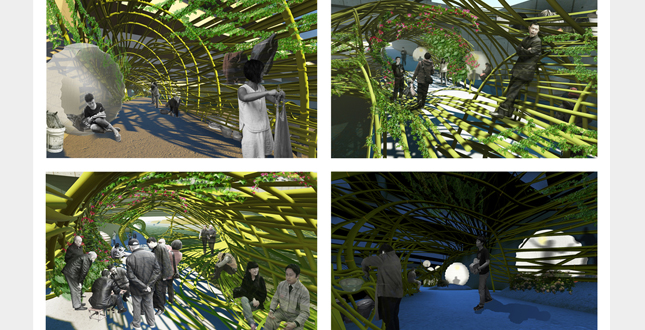 Close Me!
Close Me!For Petitioners. Petitioners' behaviors in the bamboo space.
Download Hi-Res ImageImage: Zhinian Dong, Changlin Fan, Hongxia Wang, Yiding Wang, and Chao Zhou
Image 14 of 15
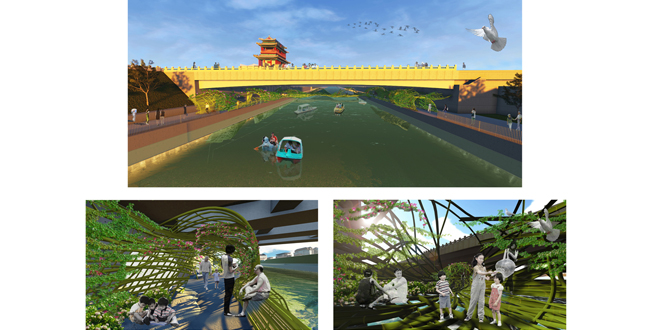 Close Me!
Close Me!For citizens. After petitioners leaving, the landscape recovered, it becomes a good place for locals to relax and exercise.
Download Hi-Res ImageImage: Zhinian Dong, Changlin Fan, Hongxia Wang, Yiding Wang, and Chao Zhou
Image 15 of 15
Project Statement
This project is for the space under Yonding Bridge in Beijing.It aim at improves the residential environment and provides sheltered accommodation for petitioners.In the project using bamboo weaving structure is formed based on petitioner’s activities: When petitioners come to Beijing appealing for help, the bamboo weaving structure provides them a space for free rein and spontaneous gathering, and the asylum air pupas freely distributed in the structure become the space for thinking, writing petition material, sleeping and rest, etc. When petitioners left, the landscape recovered, it turns into a public place for locals.This project is a spontaneous growing space, growing and spreading in line with petitioners’ using behaviors.
Project Narrative
Background
There is such a group in China called Petitioner. They’re poor and have no right to speak. They could not protect their right or even lose their home and family due to land disputes, housing conflicts, homicide cases and the like. The local governments cannot solve their problems or collude with vested interests, and they fail to vindicate their rights, so they bypass the immediate leadership and appeal to the central government. Petitioning is very common in China as right movements overseas. Petitioners from different regions vindicate their rights in their own way, continuously gather in the process of petitioning and become a strong power. Because these petitions are complicated, so the government needs time to dealing with them. In addition, petitioners always have financial difficulties with the high price of houses in Beijing. They could only find some public space (under the bridge of Yongding Gate)close to the State Bureau for Letters and Calls as their temporary shelter during the petitioning period.
Petitioning (also known as letters and calls, correspondence and reception, xinfang or shangfang) is the administrative system for hearing complaints and grievances from individuals in the People's Republic of China.
State Bureau for Letters and Calls (guojia xinfang ju) and local bureaus of letters and calls ("petitioning bureaus") are commissioned to receive letters, calls, and visits from individuals or groups on suggestions, complaints, and grievances. The officers then channel the issues to respective departments and monitor the progress of settlement, which they feedback to the filing parties.
Petitioning bureaus are ostensibly a communication channel between the government and the citizenry, and have been relied on since the establishment of the PRC in 1949. Petitioners may begin their attempts for redress at the at local-level letters and calls office, which are located in courthouses or in township-level government offices. If unsatisfied, they can move up the hierarchy to provincial level offices and, at the highest level, the State Bureau for Letters and Visits in Beijing.
Project Location
The project is under the Yongding Bridge, south of Beijing central axis, spread along the moat of Yongding Gate. The area is the nearest shelter place to the State Bureau for Letters and Calls. Petitioners gather in this place spontaneously and form their own safe space. Meanwhile, space along the moat is the place for local residents to do morning exercise relax and take walks.
Current Situation & Problems
In the process of field research, we found that petitioners’ living conditions are extremely terrible. They are like tramps, sleeping on the ground along the passage under the bridge, the bridge become their shelter and spiritual sustenance. In days, apart from going to the State Bureau for Letters and Calls and writing petition materials, they pick up waste to get some money and find some food from vegetable markets. Petitioners use the water from the river and public washrooms nearby as water for their life. There are no lights under the bridge, it’s dark at night so the streetlights nearby is the only light sources. Petitioners’ activities of daily living conflict with pedestrians. The space under the bridge is broken and lots of garbage are left when they leave.
Design Program & Intention
In allusion to the use of the space under the bridge and status quo of petitioners, we redefine this place: the corresponding relationship between matrix and daughter, it’s just like peas and peasecod. We design the space to form a new landscape (according to behaviors of petitioners and pedestrian to enrich the space of landscape)—matrix, provide air pupas for petitioners as shelters in the landscape—daughter.
Features of the landscape (matrix):
Bamboo weaving structure
Bamboo is easy to get in China. Compared with rebar, brick, concrete and other building materials, bamboo features low-carbon green, and low cost, and it has high toughness, high deformability, high axial rigidity and light weight. Various spaces made of bamboo weaving structure based on the ways of act of petitioners and passerby remit the conflicts between them.
Spontaneous growing process
The bamboo structure grows freely in line with ways of act and numbers of petitioners. At the beginning, the landscape is just a bamboo weaving structure. In petitioners’ usage, it becomes richly and expands continually. It provides shelter to petitioners who come to Beijing, and turn into landscape for surrounding residents and pedestrians to relax, stroll and exercise when they leave.
Vegetables on the structure
Plant climbing plants on the weaving structure in public, sunny area. Plants grow along the structure, which can increase vitality of this landscape Constitute plants for view, shelter and product.
Technological support
Bamboo weaving structure in the landscape could provide energy facility, water filters system and information station needed by petitioners. The energy is mainly from traffic stress store electrical energy, the transmission wires of the energy under the bridge is hidden in the center-empty bamboo weaving structure. And water filter system also use this feature to cleansing the river water to make water able to drink. Information stations that provide petitioners channels to check information are in the public area of bamboo weaving structure.
The features of asylum air pupas (daughter):
Concept
The conception of air pupa comes from <1Q84>, a fiction of Haruki Murakami. The air pupa is the shelter of tiny man. The tiny man in the fiction is a strong power exists everywhere, just the real reflection of petitioners. We quote the concept of air pupa and make it to be the shelter of petitioners in the landscape to provide private space and satisfy their spiritual needs for safety.
Structure
Asylum air pupa is formed based on behaviors of petitioners, some of they can be used for thinking, some of they can be used for writing, some of they can be used for sleeping, thus form many different shapes vary in size and heights.
Portable type
As a shelter, air pupa can open when using and fold in at other time to make the space free. meanwhile, air pupa could become privacy or half-privacy space according to the requirements of petitioners.
Spontaneous growth
Petitioners who come to Beijing enter into the landscape and put asylum air pupa freely according to their needs. So air pupas could grow freely in the landscape. When petitioners leave, the landscape recovers and the environment would not be violated but maintain sustainable state.





